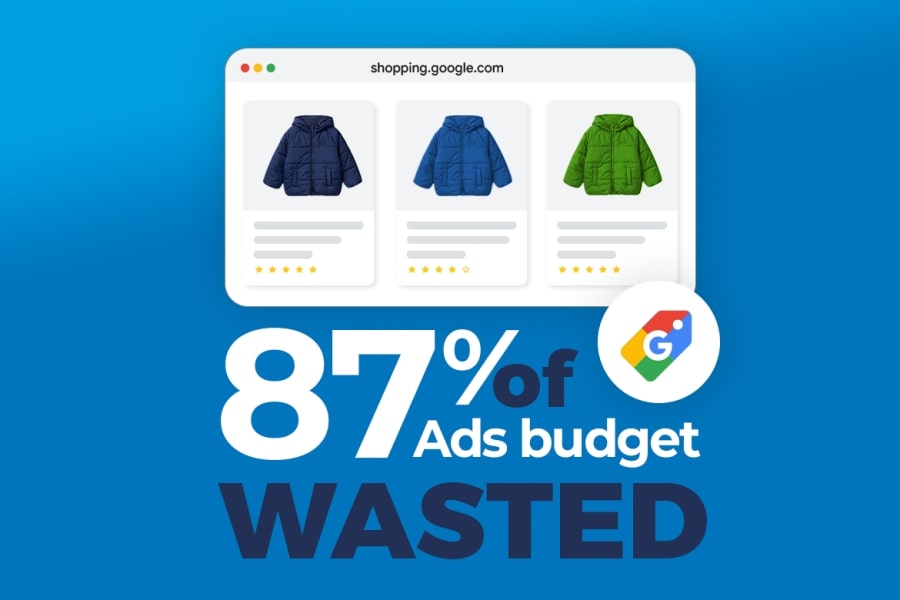Why default Google Shopping Ads strategies cost e-commerce businesses big money
Written by
Editorial TeamPublished on
Are default Google Shopping Ads draining your e-commerce budget? Learn why over 80% of ad spend often goes to products that don’t sell and how smarter strategies can unlock higher ROI. Discover actionable tips to optimize your ad budget and outpace rising CPC trends—don’t miss this essential guide! (Ad)

Commercial collaboration
The facts
For most e-commerce businesses, more than 87% of their Ads budget is allocated to Google Ads1. Shopping Ads are a major component of this landscape. Not only have they transformed how customers find and buy products online, but they have also become a crucial source of revenue for brands in nearly every industry.
Given this substantial investment, optimizing Google Shopping Ads should be a top priority for profitability. Yet, many e-commerce managers and executives continue to rely on default setups, unaware of the significant budget inefficiencies this approach entails.
Rising costs: A warning sign
The cost-per-click (CPC) for Google Shopping Ads has been on a steady incline, with a notable 13% increase year-on-year in Q1 2024, compared to a 6% rise in Q4 20232. This rise is driven by the growing reliance on Shopping Ads for traffic and changes in Google’s search results, which now prioritize paid over organic listings. With organic visibility shrinking, competition for paid spots intensifies, further pushing up CPCs. Over the past five years, retail brands running Google search ads have seen their average CPC rise by 40-50%3, a trend that shows no signs of slowing down, making ad spend optimization crucial for businesses.

Budget misallocation: The core issue
Internal data from numerous eshops reveal that up to 80% of the budget allocated to Google Shopping Ads is spent on products that never sell. This staggering inefficiency underscores the critical challenge: how to allocate the Shopping Ads budget effectively.
For businesses looking to assess their own performance breakdown, Shoply’s Google Ads Free Audit Tool provides actionable insights. Detailed reports highlight both top-performing products and wasted spend.
Since ad budgets are finite and searches are vast, someone (or something) must decide which products to prioritize in ads and how much to bid for them. When businesses rely on default setups, the algorithms tend to make suboptimal choices, leading to the following issues:
- Prioritization of high-demand products: Google’s algorithms often focus on products with higher demand. While these products may generate traffic, they’re also the most competitive. Many e-commerce stores sell these items, often engaging in price wars that erode profitability.
- Neglect of other products: As high-demand products consume the majority of the budget, lower-demand products are left underfunded. This creates a common scenario where up to 60% of an e-commerce store’s products receive zero clicks from ads.
- Learning period costs: When new products are added to an e-commerce catalog, Google requires a learning period to gather performance data. During this phase, a significant budget can be wasted before the algorithm optimizes for these products.
- Missed opportunities during peak seasons: In high-demand periods, specific products can achieve exceptional ROAS (Return on Ad Spend) or sell out quickly. However, by the time Google’s algorithm adjusts, the opportunity to capitalize on these trends has often passed.
- Limited conversion data: By default, Google’s bidding algorithm relies primarily on online conversion data. For retailers with physical stores, this excludes a large portion of total sales data, leading to an incomplete optimization process. Integrating offline sales data into the ad strategy can significantly enhance decision-making.
The solution: smarter budget allocation
To address these issues, businesses must take control of their Google Shopping Ads strategies. Here are four actionable steps:
- Control overspending on low-performing products: Identify and limit budget allocation to products with consistently poor performance.
- Prioritize high-ROAS potential products: Use predictive analytics and historical data to identify and prioritize products likely to generate high returns—even those with limited or no ad data.
- Turn cross-channel data into smarter ad investment decisions: Combine Google Ads data with other insights, such as sales from physical stores, CRM data, and inventory levels, to inform budget decisions.
- Incorporate real-time data: Integrate real-time sales and inventory data into your ad strategy to seize opportunities quickly and maximize momentum during peak seasons.

Conclusion
Default Google Shopping Ads setups may seem convenient, but they’re often a recipe for wasted budget and lost profitability. By understanding the pitfalls of these setups and implementing smarter strategies, e-commerce businesses can take control of their ad spend, reduce inefficiencies, and maximize ROI. The time to act is now—the cost of inaction only increases with every click.
Sources:
- eMarketer. (2024). U.S. digital retail media ad spending, 2019-2023 (billions) and change (% of digital ad spending)
↩︎ - Adegbola, A. (2024, April 24). Report: Google Search CPC up 13% YoY; ad spend growth slowing. Search Engine Land.
↩︎ - Adegbola, A. (2024, April 24). Report: Google Search CPC up 13% YoY; ad spend growth slowing. Search Engine Land.
↩︎
About the author
Nikolaos Kostroglou, Co-Founder of Shoply
Nikolaos Kostroglou is a prominent figure in e-commerce advertising, partner at Koolmetrix and founder of Shoply. With a solid background in finance and statistics, he excels in leveraging data to drive strategic marketing decisions. As the founder of Shoply, Nikolaos has pioneered innovative solutions. His expertise lies in utilizing statistical methods and advanced customization techniques to optimize e-commerce advertising. Committed to excellence, Nikolaos integrates data analysis and strategic insights to ensure marketing efforts are efficient and highly effective, revolutionizing how e-commerce ads are optimized
***


